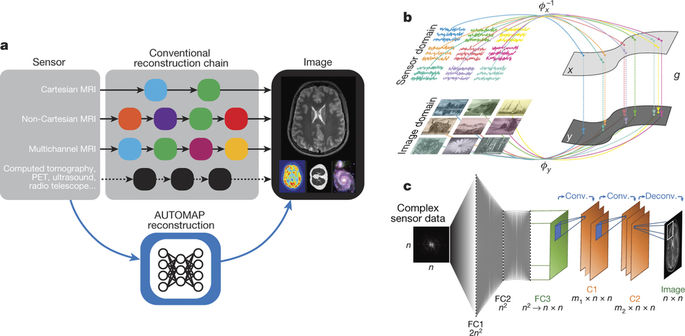Our official English website, www.x-mol.net, welcomes your
feedback! (Note: you will need to create a separate account there.)
Image reconstruction by domain-transform manifold learning
Nature ( IF 50.5 ) Pub Date : 2018-03-01 , DOI: 10.1038/nature25988 Bo Zhu , Jeremiah Z. Liu , Stephen F. Cauley , Bruce R. Rosen , Matthew S. Rosen
Nature ( IF 50.5 ) Pub Date : 2018-03-01 , DOI: 10.1038/nature25988 Bo Zhu , Jeremiah Z. Liu , Stephen F. Cauley , Bruce R. Rosen , Matthew S. Rosen

|
Image reconstruction is essential for imaging applications across the physical and life sciences, including optical and radar systems, magnetic resonance imaging, X-ray computed tomography, positron emission tomography, ultrasound imaging and radio astronomy. During image acquisition, the sensor encodes an intermediate representation of an object in the sensor domain, which is subsequently reconstructed into an image by an inversion of the encoding function. Image reconstruction is challenging because analytic knowledge of the exact inverse transform may not exist a priori, especially in the presence of sensor non-idealities and noise. Thus, the standard reconstruction approach involves approximating the inverse function with multiple ad hoc stages in a signal processing chain, the composition of which depends on the details of each acquisition strategy, and often requires expert parameter tuning to optimize reconstruction performance. Here we present a unified framework for image reconstruction—automated transform by manifold approximation (AUTOMAP)—which recasts image reconstruction as a data-driven supervised learning task that allows a mapping between the sensor and the image domain to emerge from an appropriate corpus of training data. We implement AUTOMAP with a deep neural network and exhibit its flexibility in learning reconstruction transforms for various magnetic resonance imaging acquisition strategies, using the same network architecture and hyperparameters. We further demonstrate that manifold learning during training results in sparse representations of domain transforms along low-dimensional data manifolds, and observe superior immunity to noise and a reduction in reconstruction artefacts compared with conventional handcrafted reconstruction methods. In addition to improving the reconstruction performance of existing acquisition methodologies, we anticipate that AUTOMAP and other learned reconstruction approaches will accelerate the development of new acquisition strategies across imaging modalities.
中文翻译:

通过域变换流形学习重建图像
图像重建对于物理和生命科学的成像应用至关重要,包括光学和雷达系统、磁共振成像、X 射线计算机断层扫描、正电子发射断层扫描、超声成像和射电天文学。在图像采集期间,传感器对传感器域中对象的中间表示进行编码,随后通过编码函数的反转将其重建为图像。图像重建具有挑战性,因为精确逆变换的分析知识可能不存在先验,尤其是在存在传感器非理想性和噪声的情况下。因此,标准的重建方法涉及在信号处理链中用多个 ad hoc 阶段逼近反函数,其组成取决于每个采集策略的细节,通常需要专家参数调整来优化重建性能。在这里,我们提出了一个统一的图像重建框架——流形逼近自动变换(AUTOMAP)——它将图像重建重铸为数据驱动的监督学习任务,允许传感器和图像域之间的映射从适当的训练语料库中出现数据。我们使用深度神经网络实现 AUTOMAP,并展示了其在学习各种磁共振成像采集策略的重建变换方面的灵活性,使用相同的网络架构和超参数。我们进一步证明,训练期间的流形学习会导致沿低维数据流形的域变换的稀疏表示,并观察到与传统的手工重建方法相比具有更好的抗噪性和重建伪影的减少。除了提高现有采集方法的重建性能外,我们预计 AUTOMAP 和其他学习重建方法将加速跨成像模式的新采集策略的开发。
更新日期:2018-03-01
中文翻译:

通过域变换流形学习重建图像
图像重建对于物理和生命科学的成像应用至关重要,包括光学和雷达系统、磁共振成像、X 射线计算机断层扫描、正电子发射断层扫描、超声成像和射电天文学。在图像采集期间,传感器对传感器域中对象的中间表示进行编码,随后通过编码函数的反转将其重建为图像。图像重建具有挑战性,因为精确逆变换的分析知识可能不存在先验,尤其是在存在传感器非理想性和噪声的情况下。因此,标准的重建方法涉及在信号处理链中用多个 ad hoc 阶段逼近反函数,其组成取决于每个采集策略的细节,通常需要专家参数调整来优化重建性能。在这里,我们提出了一个统一的图像重建框架——流形逼近自动变换(AUTOMAP)——它将图像重建重铸为数据驱动的监督学习任务,允许传感器和图像域之间的映射从适当的训练语料库中出现数据。我们使用深度神经网络实现 AUTOMAP,并展示了其在学习各种磁共振成像采集策略的重建变换方面的灵活性,使用相同的网络架构和超参数。我们进一步证明,训练期间的流形学习会导致沿低维数据流形的域变换的稀疏表示,并观察到与传统的手工重建方法相比具有更好的抗噪性和重建伪影的减少。除了提高现有采集方法的重建性能外,我们预计 AUTOMAP 和其他学习重建方法将加速跨成像模式的新采集策略的开发。











































 京公网安备 11010802027423号
京公网安备 11010802027423号